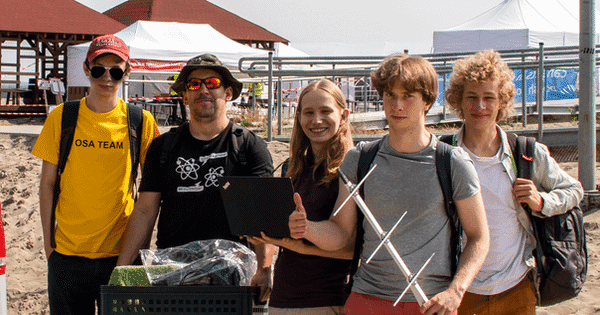OSA (falling atmospheric satellite) is an innovative project of 4 high school students from Krakow. They won one of the most challenging engineering competitions for teenagers, “The European CanSat Competitions 2021.” Teenagers designed and then constructed a mini-satellite that carries out various research missions when dropped from a rocket. The competition is organized by the European Space Agency.
It all started two years ago with the application of the OSA Team to the national edition of the CanSat 2020/21 competition. The competition task was to develop a mini-satellite the size of a soda can. The challenge required knowledge in mechanics, electronics, programming, radio communication. And linking it with cosmology, physics, chemistry, and IT. Each team had to meet the essential mission criteria: downloading and sending temperature and pressure measurements. The team from Krakow also undertook an additional task – taking air samples at different altitudes of the atmosphere. NASA’s research on Venus inspired this challenge.
The purpose of sending these cans to another planet was to study the atmosphere’s structure at its entire height. However, instead of sending expensive probes with sophisticated atmospheric systems to transmit all data to a ground station, they proposed something different. It means sending hundreds of small OSA probes that would take samples and then deliver them safely to the planet’s surface. The devices with the collected samples would then be collected by a rover, on which a laboratory would be installed. The samples will be automatically analyzed and the data sent to Earth.

How does it work?
Teenagers admit that the project involved a lot of work and effort. It was often necessary to look for new solutions and work on elements for many hours. One of the biggest challenges for young scientists was to limit the size of their CanSat. Its maximum diameter could be as low as 66 mm. The goal was achieved thanks to 3D design. Eventually, their mini-satellite can be dropped from various flying machines. He takes samples in a few seconds when he descends on a parachute.
Participating in the competition also had to get sponsors and fit in the appropriate budget. The team did not give up. Many prototypes were created and tested in the Earth’s atmosphere. They were thrown from rocks, from a drone, and eventually even from a rocket. The final prototype took part in the national CanSat competition. The team managed to win it, thanks to which they took part in the European finals, which they also won.
Technical details
The work immediately before the finals aimed to provide the probe with systems that would bring it closer to participating in a real space mission. That is why the exact location system by the UWB (Ultra WideBand) transmitter and the mechanism for rejecting the parachute and other unnecessary elements from the tube module was used. The weight and volume of the probes were also reduced to a minimum, It was because the rover that was supposed to collect them had a limited cargo space. A successful attempt was also to drop the probe from a height of 30 km during a meteorological balloon flight. It was also necessary to adapt the components to the harsh climatic conditions occurring at high altitudes. The shallow temperature could prevent the proper operation of the device.
OSA Team took part in the finals: Aleksy Grymek, Stanisław Michalik, Miłosz Słowiński, Piotr Wyżliński.
A description of the entire project is available on GitHub here.
Read more about a medal for Polish university in World Robot Summit 2021 for Mars rover here.




